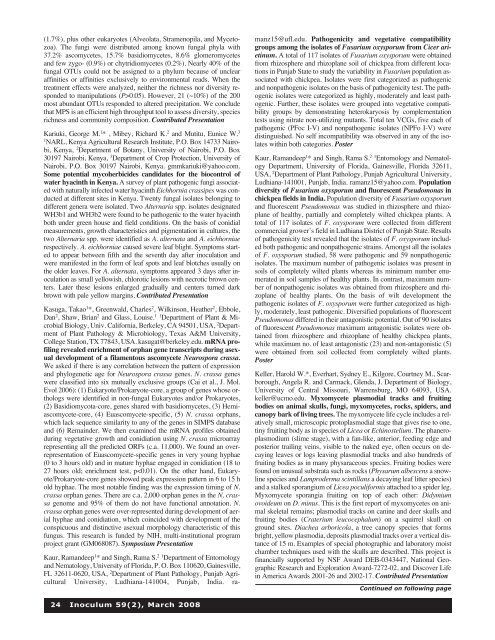March 2008 - Mycological Society of America
March 2008 - Mycological Society of America
March 2008 - Mycological Society of America
You also want an ePaper? Increase the reach of your titles
YUMPU automatically turns print PDFs into web optimized ePapers that Google loves.
(1.7%), plus other eukaryotes (Alveolata, Stramenopila, and Mycetozoa).<br />
The fungi were distributed among known fungal phyla with<br />
37.2% ascomycetes, 15.7% basidiomycetes, 8.6% glomeromycetes<br />
and few zygo- (0.9%) or chytridiomycetes (0.2%). Nearly 40% <strong>of</strong> the<br />
fungal OTUs could not be assigned to a phylum because <strong>of</strong> unclear<br />
affinities or affinities exclusively to environmental reads. When the<br />
treatment effects were analyzed, neither the richness nor diversity responded<br />
to manipulations (P>0.05). However, 21 (~10%) <strong>of</strong> the 200<br />
most abundant OTUs responded to altered precipitation. We conclude<br />
that MPS is an efficient high throughput tool to assess diversity, species<br />
richness and community composition. Contributed Presentation<br />
Kariuki, George M. 1 * , Mibey, Richard K. 2 and Mutitu, Eunice W. 3<br />
1 NARL, Kenya Agricultural Research Institute, P.O. Box 14733 Nairobi,<br />
Kenya, 2 Department <strong>of</strong> Botany, University <strong>of</strong> Nairobi, P.O. Box<br />
30197 Nairobi, Kenya, 3 Department <strong>of</strong> Crop Protection, University <strong>of</strong><br />
Nairobi, P.O. Box 30197 Nairobi, Kenya. gmmkariuki@yahoo.com.<br />
Some potential mycoherbicides candidates for the biocontrol <strong>of</strong><br />
water hyacinth in Kenya. A survey <strong>of</strong> plant pathogenic fungi associated<br />
with naturally infected water hyacinth Eichhornia crassipes was conducted<br />
at different sites in Kenya. Twenty fungal isolates belonging to<br />
different genera were isolated. Two Alternaria spp. isolates designated<br />
WH3b1 and WH3b2 were found to be pathogenic to the water hyacinth<br />
both under green house and field conditions. On the basis <strong>of</strong> conidial<br />
measurements, growth characteristics and pigmentation in cultures, the<br />
two Alternaria spp. were identified as A. alternata and A. eichhorniae<br />
respectively. A. eichhorniae caused severe leaf blight. Symptoms started<br />
to appear between fifth and the seventh day after inoculation and<br />
were manifested in the form <strong>of</strong> leaf spots and leaf blotches usually on<br />
the older leaves. For A. alternata, symptoms appeared 3 days after inoculation<br />
as small yellowish, chlorotic lesions with necrotic brown centers.<br />
Later these lesions enlarged gradually and centers turned dark<br />
brown with pale yellow margins. Contributed Presentation<br />
Kasuga, Takao 1 *, Greenwald, Charles 2 , Wilkinson, Heather 2 , Ebbole,<br />
Dan 2 , Shaw, Brian 2 and Glass, Louise. 11 Department <strong>of</strong> Plant & Microbial<br />
Biology, Univ. California, Berkeley, CA 94501, USA, 2 Department<br />
<strong>of</strong> Plant Pathology & Microbiology, Texas A&M University,<br />
College Station, TX 77843, USA. kasugat@berkeley.edu. mRNA pr<strong>of</strong>iling<br />
revealed enrichment <strong>of</strong> orphan gene transcripts during asexual<br />
development <strong>of</strong> a filamentous ascomycete Neurospora crassa.<br />
We asked if there is any correlation between the pattern <strong>of</strong> expression<br />
and phylogenetic age for Neurospora crassa genes. N. crassa genes<br />
were classified into six mutually exclusive groups (Cai et al., J. Mol.<br />
Evol 2006): (1) Eukaryote/Prokaryote-core, a group <strong>of</strong> genes whose orthologs<br />
were identified in non-fungal Eukaryotes and/or Prokaryotes,<br />
(2) Basidiomycota-core, genes shared with basidiomycetes, (3) Hemiascomycete-core,<br />
(4) Euascomycete-specific, (5) N. crassa orphans,<br />
which lack sequence similarity to any <strong>of</strong> the genes in SIMPS database<br />
and (6) Remainder. We then examined the mRNA pr<strong>of</strong>iles obtained<br />
during vegetative growth and conidiation using N. crassa microarray<br />
representing all the predicted ORFs (c.a. 11,000). We found an overrepresentation<br />
<strong>of</strong> Euascomycete-specific genes in very young hyphae<br />
(0 to 3 hours old) and in mature hyphae engaged in conidiation (18 to<br />
27 hours old; enrichment test, p
















